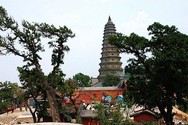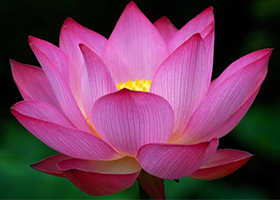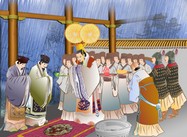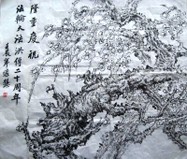Art and Culture
Art | Music | Poetry | Literature | Culture | New Science | Ancient Cultivation Stories
-
Stories from Ancient China: Ancient Chinese Cooled Foods With Ice
2012-09-20 Dating from 147 A.D, Guangsheng Temple near Huoshan Mountain in China’s Shanxi province is renowned for its 13-story “Flying Rainbow Pagoda” and its murals which portray the local populace propitiating the Water God during the Yuan Dynasty (1271-1368).
Dating from 147 A.D, Guangsheng Temple near Huoshan Mountain in China’s Shanxi province is renowned for its 13-story “Flying Rainbow Pagoda” and its murals which portray the local populace propitiating the Water God during the Yuan Dynasty (1271-1368). -
Stories from Ancient China: The Yellow Emperor, Ancestor of Chinese Civilization
2012-09-11 After Shen Nong the Yellow Emperor took responsibility for keeping stability for the whole territory. He led people to settle in the Yellow River Basin and changed their way of life from hunting to building houses, raising livestock and planting crops.
After Shen Nong the Yellow Emperor took responsibility for keeping stability for the whole territory. He led people to settle in the Yellow River Basin and changed their way of life from hunting to building houses, raising livestock and planting crops. -
Stories from Ancient China: Changjie, Creator of Chinese Characters
2012-09-07 One day, while walking in the mountains, Changjie came across a giant turtle. The blue lines on that turtle’s shell drew his attention. He studied the lines carefully and found intrinsic meaning in their patterns. He had the idea that people also could express thoughts and meaning or record things by simple symbols like those on the turtle’s back.
One day, while walking in the mountains, Changjie came across a giant turtle. The blue lines on that turtle’s shell drew his attention. He studied the lines carefully and found intrinsic meaning in their patterns. He had the idea that people also could express thoughts and meaning or record things by simple symbols like those on the turtle’s back. -
The Emperor Yao
2012-08-31 Emperor Yao’s concern for his people won him great respect. He lived a simple life and put the people’s well-being as his highest priority. He always looked inward first when encountering difficulties. Emperor Yao was loved deeply by his people. During his reign the people’s lives got better and better.
Emperor Yao’s concern for his people won him great respect. He lived a simple life and put the people’s well-being as his highest priority. He always looked inward first when encountering difficulties. Emperor Yao was loved deeply by his people. During his reign the people’s lives got better and better. -
The Rescue of the Dragon Princess, Part III of III
2012-08-28 The dragon princess, third daughter of the Dong Ting Lake Dragon King, was married to the dragon prince of the Jinghe River, a ruthless, cruel, unfeeling and obstinate dragon that mistreated the princess and exiled her from the palace.
The dragon princess, third daughter of the Dong Ting Lake Dragon King, was married to the dragon prince of the Jinghe River, a ruthless, cruel, unfeeling and obstinate dragon that mistreated the princess and exiled her from the palace. -
The Rescue of the Dragon Princess, Part II of III
2012-08-21 The dragon princess, third daughter of the Dong Ting Lake Dragon King, was married to the dragon prince of the Jinghe River, a ruthless, cruel, unfeeling and obstinate dragon who mistreated the princess and exiled her from the palace. Liu Yi, a young scholar, heard the princess’s sorrowful cry and took pity on the damsel in distress.
The dragon princess, third daughter of the Dong Ting Lake Dragon King, was married to the dragon prince of the Jinghe River, a ruthless, cruel, unfeeling and obstinate dragon who mistreated the princess and exiled her from the palace. Liu Yi, a young scholar, heard the princess’s sorrowful cry and took pity on the damsel in distress. -
The Rescue of the Dragon Princess, Part I of III
2012-08-17 Throughout the ages, Chinese legends have been passed down from generation to generation and, at times, these stories have taken on a life of their own as new events would happen and characters would appear. The legend of Liu Yi delivering a letter for the dragon princess has grown in popularity since it was first heard in ancient China.
Throughout the ages, Chinese legends have been passed down from generation to generation and, at times, these stories have taken on a life of their own as new events would happen and characters would appear. The legend of Liu Yi delivering a letter for the dragon princess has grown in popularity since it was first heard in ancient China. -
Stories from Ancient China: Emperor Shun Inspired by Example
2012-08-14 Many centuries preceding the teachings of Confucius in the 5th century B.C., Emperor Shun was known as the founder of China’s social rules in the family and among the various members of society. He said there should be affection between father and son, justice between a monarch and his ministers, duty between husband and wife, respect for ones’ elders, and trust among friends.
Many centuries preceding the teachings of Confucius in the 5th century B.C., Emperor Shun was known as the founder of China’s social rules in the family and among the various members of society. He said there should be affection between father and son, justice between a monarch and his ministers, duty between husband and wife, respect for ones’ elders, and trust among friends. -
Stories from Ancient China: Great Yu Controlled the Flood (B.C. 2205)
2012-08-10 After Emperor Shun, Yu became the next Emperor (B.C. 2205). Yu was one of descendants of the Yellow Emperor. Being known for his kindness and talent, Yu was recommended by many ministers as the most capable person to find ways to control flooding. He was then appointed by Emperor Shun to take the responsibility of flood-control.
After Emperor Shun, Yu became the next Emperor (B.C. 2205). Yu was one of descendants of the Yellow Emperor. Being known for his kindness and talent, Yu was recommended by many ministers as the most capable person to find ways to control flooding. He was then appointed by Emperor Shun to take the responsibility of flood-control. -
Stories from Ancient China: Compassionate Tang Founded the Shang Dynasty
2012-08-07 In the first five years of Tang’s reign, there were several droughts and all the rivers dried up. Tang ordered golden coins to be made and distributed to poor families who had been forced to sell their children. He intended for them to use this money to buy their children back. The droughts nonetheless continued.
In the first five years of Tang’s reign, there were several droughts and all the rivers dried up. Tang ordered golden coins to be made and distributed to poor families who had been forced to sell their children. He intended for them to use this money to buy their children back. The droughts nonetheless continued. -
The Virtue of Tolerance
2012-08-03 Cui Lo was appointed the deputy prime minister, and was highly regarded and respected by Emperor Shizong. Cui liked to promote talent. He recommended Xing Shao to the Emperor as staff in the prime minister’s office, and also as head of covert operations. Because of Cui’s recommendation, Xing was recruited. Xing later won the Emperor’s trust and high regard.
Cui Lo was appointed the deputy prime minister, and was highly regarded and respected by Emperor Shizong. Cui liked to promote talent. He recommended Xing Shao to the Emperor as staff in the prime minister’s office, and also as head of covert operations. Because of Cui’s recommendation, Xing was recruited. Xing later won the Emperor’s trust and high regard. -
Ink Drawings: Plum Trees
2012-07-27 To celebrate the 20th anniversary of Falun Dafa’s public introduction, I drew three images of plum trees. The plum trees symbolize Falun Dafa practitioners being steadfast while facing the persecution. Practitioners assist Master in Fa-rectification, saving sentient beings, and fulfilling their prehistorical vows.
To celebrate the 20th anniversary of Falun Dafa’s public introduction, I drew three images of plum trees. The plum trees symbolize Falun Dafa practitioners being steadfast while facing the persecution. Practitioners assist Master in Fa-rectification, saving sentient beings, and fulfilling their prehistorical vows. -
Midsummer Snow: The Injustice to Dou Er
2012-07-27 Guan Hanqing was a scholar in the early Yuan Dynasty and a talented writer of Yuan Dramas. During his time, corruption and botched up court cases were rampant. Guan, a person with a strong sense of justice, wrote many dramas to expose the state of affairs. “The Injustice of Dou Er” is perhaps Guan’s most outstanding of his “Injustice” oeuvre.
Guan Hanqing was a scholar in the early Yuan Dynasty and a talented writer of Yuan Dramas. During his time, corruption and botched up court cases were rampant. Guan, a person with a strong sense of justice, wrote many dramas to expose the state of affairs. “The Injustice of Dou Er” is perhaps Guan’s most outstanding of his “Injustice” oeuvre. -
Watercolor Painting: Promoting Shen Yun at Cherry Festival
2012-07-24
-
Stories from Ancient China: The Legend of Mulan
2012-07-24 As Mulan thought of her father going to war, she knew he would likely die, and die in vain. But if he refused to go, he would be branded as being unpatriotic. Mulan’s brother was still too young to enlist, so Mulan made up her mind to disguise herself as a man, and take her father’s place in the army. At first, Mulan’s parents were against her plan, but Mulan persisted.
As Mulan thought of her father going to war, she knew he would likely die, and die in vain. But if he refused to go, he would be branded as being unpatriotic. Mulan’s brother was still too young to enlist, so Mulan made up her mind to disguise herself as a man, and take her father’s place in the army. At first, Mulan’s parents were against her plan, but Mulan persisted.



 more ...
more ...